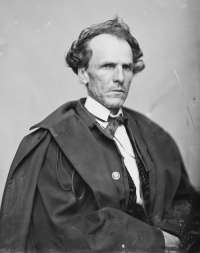James H. Lane

James Henry Lane was a prominent figure in establishing Kansas as a “free state.” As a key figure in “Bleeding Kansas,” he also terrorized the inhabitants of Missouri counties sharing a border with Kansas. Lane used his jayhawking tactics during the Civil War while leading the Kansas Brigade.
James Henry Lane was born on June 22, 1814 in Lawrenceburg, Indiana, the son of an Indiana politician. After serving in the War with Mexico as a Col. of Volunteers, Lane returned to Indiana to enter politics. In 1852 running as a Democrat, Lane was elected to represent the Fourth District of Indiana in the U.S. House of Representatives. In 1855, Lane decided to make a new start, and went to the newly formed Territory of Kansas.
Lane came down decidedly on the side of Free-State men and was placed in command of the Free-State Militia. He helped to form the Republican Party in Kansas. When Kansas was admitted as the country’s 34th state, the State Legislature elected Lane to represent Kansas in the United States Senate.
When the American Civil War began in April 1861, many believed there was a very real threat the Confederates were going to attack Washington. Back in March, Lane had offered President-elect Abraham Lincoln a “body guard of Kansas men” to escort him to the inauguration in Washington. Lincoln had politely declined Lane’s offer. But now with the threat on Washington, Lane again offered to provide personal security for Lincoln with his “Frontier Guard.” This time the President accepted the offer. On April 18 Lane and his Frontier Guard took up residence in the East Room of the White House. The Frontier Guard remained Lincoln’s body guard for just over two weeks. By then, enough Federal Volunteer Regiments from northern states had entered the city to protect it from attack.
Lincoln authorized Lane’s appointment as a brigadier general of volunteers. Lane raised and organized the Kansas Brigade, consisting of three volunteer regiments. Soon Lane began to realize that hurting the institution of Slavery would harm directly the Confederate States of America. Each slave that escaped was one less slave that provided support to the enemy. As early as November 1861, Lane began to argue that freeing all the slaves would hasten the defeat of the Confederacy.
James H. Lane decided to take it upon himself to put all of these African-Americans to good use fighting the war. On July 22, 1862, Lane received an appointment as commissioner for recruiting in the Department of Kansas. Lane was the driving force behind the recruitment of the 1st Kansas Colored Infantry. Units from this regiment were the first Federalized African-American soldiers to see combat (Island Mound) in the Civil War.
In August 1863, Lane was one of the targets during William Quantrill’s raid on Lawrence, Kansas. During the raid, Quantrill concluded that Lane was not present in town, although Lane was there and supposedly hit in a cornfield to escape capture. After the raid, Lane led a posse in pursuits after the raiders left Lawrence.
By the summer of 1864, Lane is focused on the fall election but offered his services as an aide to Maj. Gen. Samuel R. Curtis during Price’s raid.
As Confederate Major General Sterling Price began to move his army west across Missouri, Senator Lane was one of the individuals who argued strongly for Kansas Governor Thomas Carney to mobilize the state militia in defense of the border. Eventually, Carney called up the militia, who were important in helping defeat Price's army at the Battle of Wesport.
During Price's Raid into Missouri is the fall of 1864, Lane was involved in the planning for the pursuit of the retreating Confederates following their defeat at the Battle of Westport. He wanted to be sure that the Kansas Volunteers would be able to get leave in order to vote in the fall elections in 1864. Lane continued to accompany the Federal army in pursuit of Price's retreating army. Just before the The Battle of Charlot's Farm (Marmaton River), Union Brig. Gen. John McNeil sent Senator Lane back for reinforcements.
Kansas Senator James H. Lane's call for mobilization of the militia had been initially opposed by Kansas Governor Thomas Carney. By being associated with the victory at Mine Creek, the entire Lane ticket was elected. Brig. Gen. Samuel Crawford, also present at Mine Creek, was elected Governor of Kansas.
Reelected to the Senate in 1865, Lane threw his support behind beleaguered President Andrew Johnson's reconstruction policies. In doing so he drew the wrath of the Radical Republicans. They attacked him, accusing him of fraudulent financial dealings. In fit of depression, Lane shot himself on July 1, 1866. He died 10 days later on July 11, 1866. James Henry Lane was buried in Oak Hill Cemetery, 1605 Oak Hill Ave., Lawrence, KS 66044.